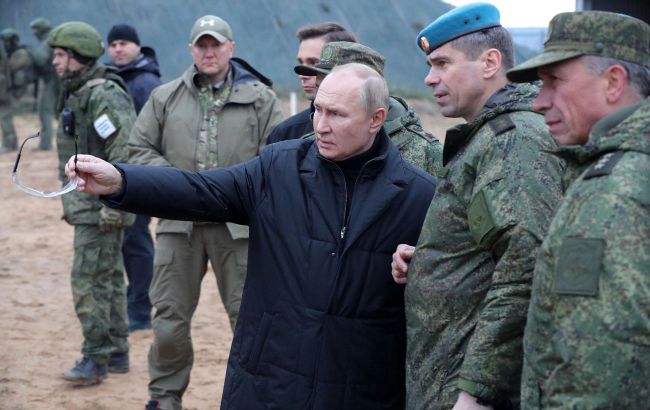Russia again delays its deadline to capture Donetsk region – Sources
 Photo: Russian dictator Vladimir Putin (Getty Images)
Photo: Russian dictator Vladimir Putin (Getty Images)
Despite Russia's broad efforts to capture the entire Donetsk region by the end of this year, the deadline for its occupying forces has reportedly been pushed back to March 2026.
This was reported by RBC-Ukraine in the article "Russian autumn offensive: How Ukrainian forces respond to enemy's new tactics."
Russia's plans in Donetsk region
According to the outlet’s source, even the new deadlines look unrealistic, as Russia is unlikely to capture the entire region by 2027 if its current pace of advance continues. The challenges of storming urban areas and potential Ukrainian counterattacks are also being taken into account.
Military sources told the outlet that Russia’s initial plan in this sector was to extend its "tentacle" northwest toward Barvinkove by the end of September, cutting through the northern part of Donetsk region and expanding the flanks of the salient toward both Pokrovsk and the Kramatorsk agglomeration.
Those plans, however, have remained only on paper. The weak spot for Russian forces turned out to be the "neck" of the Dobropillia bulge, where the fiercest fighting is now concentrated.
As RBC-Ukraine previously reported, Russian forces sent reinforcements there to prevent their units from being encircled and to push Ukrainian troops back.
Over the past two weeks, the enemy has carried out several mechanized assaults — a tactic now rarely seen on the front. Armored columns of Russian marines advancing toward Volodymyrivka and Shakhove in an attempt to widen the same "neck" of the salient were destroyed.
Military sources explained that the expansion of the salient has been halted and significantly narrowed, though Ukrainian forces have not yet managed to eliminate it entirely.
Assault attempts near Pokrovsk and Kupiansk
At the same time, Russian forces are trying to advance directly toward Pokrovsk. The most vulnerable area appears to be the city’s southwestern outskirts — from the direction of Leontovychi and Troyanda. OSINT analysts note that some streets near these villages are already under Russian control or remain in a gray zone.
A similar situation is unfolding in Kupiansk, another key target of Moscow’s autumn campaign. In September, the enemy managed to infiltrate the city through a gas pipeline, which was later flooded by Ukrainian forces.
The Russians are also pressing on Kupiansk from the north. The situation there remains unstable, with several OSINT observers reporting Russian soldiers operating almost in the city center.
"The importance of Kupiansk for them lies primarily in the fact that it serves as a logistical route for our grouping on the eastern bank of the Oskil River. Secondly, it provides a convenient bridgehead for an offensive toward Lyman, Siversk, and consequently Sloviansk. And thirdly, there is an informational and political effect — imagine losing again the city that we recaptured in 2022," one of RBC-Ukraine's military sources explained.
Situation on other frontlines
The enemy is attempting to advance toward the Kramatorsk agglomeration from the south, moving closer to Kostyantynivka. However, despite progress in Toretsk, fighting continues for the western part of Chasiv Yar. This significantly slows the enemy’s plans to encircle Kostyantynivka from the south, east, and northeast.
Another challenging area remains the Oleksandrivka sector — the junction of Donetsk, Dnipropetrovsk, and Zaporizhzhia regions (formerly known as the Novopavlivka sector).
Russian occupation forces have regrouped their troops there and are trying to push deeper into Dnipropetrovsk region toward the Zaporizhzhia–Donetsk highway. In September, the enemy captured more territory in this area than anywhere else along the front — roughly 130–140 square kilometers.
Situation in the Zaporizhzhia sector
Although Russia’s Chief of General Staff Valery Gerasimov named the Zaporizhzhia front as one of the key priorities, no major progress has been observed there. Russian troops tried to advance toward Stepnohirsk but were eventually pushed back.
Meanwhile, a week ago, Ukrainian forces launched their own counteroffensive actions in Zaporizhzhia region, liberating the villages of Mali Shcherbaky, Shcherbaky, and partially Stepove.
Two sources told the outlet that the Russian command has not abandoned plans for a more active offensive in the region, but has had to postpone them due to a lack of success on other fronts.
"They do not have enough troops for everything at once. And considering that they are now trying to secure the Donetsk region for themselves, they need to show the greatest progress precisely there. As for the Zaporizhzhia region, it remains secondary for them: 'if they manage to push somewhere — let them,'" one of RBC-Ukraine’s sources explained.
Earlier, The Washington Post reported that during a conversation with US President Donald Trump, Russian dictator Vladimir Putin demanded that Ukraine give up Donetsk region. In exchange, he allegedly offered to return the occupied parts of Zaporizhzhia and Kherson regions.

